As a housewarming gift, we received heirloom tomato seeds from a good friend of ours. I’ve never actually tried starting tomatoes from seed before now, so it was a bit of a learning experience. I think I may have started them too late, but the plants are in the ground now, so we’ll see how they go.
What is an Heirloom Tomato?
The basic difference between heirloom tomatoes and the tomatoes that are commercially grown is the type of pollination.
Heirloom tomatoes are open pollinated, which is pollination by natural means, such as insects, birds, and the wind. Seeds from these plants will produce new generations of plants because the breeding is uncontrolled – hence the different varieties of heirloom tomatoes, vs the red commercial tomatoes (hybrids) we all know. When purchasing tomatoes at the grocery store or veggie mart, the difference in taste between heirloom and hybrid is so distinct because the hybrids are typically picked green and ripen en-route, while the heirlooms are vine-ripened. If you are growing your own tomatoes, then the heirloom vs hybrid difference isn’t so great, because you can let them all vine-ripen in the garden.
Because heirloom tomatoes are allowed to ripen naturally, they are found only in season. Ripe heirloom tomatoes are relatively fragile and do not keep long. They can be kept at room temperature, out of direct sunlight, only a day or two. Tomatoes should not be refrigerated, as refrigeration causes both flavor and texture to deteriorate.
Colors include shades of white, yellow, green, pink, orange, red, purple, and black. Some varieties of heirloom tomatoes yield fruit in combinations of colors. In general, the lighter the color, the less acidic or sweeter the tomato tastes. Conversely, the deeper the color, the more acidic and definitive the tomato tastes.
Heirloom tomato plants are more susceptible to disease and are quite delicate. I was actually shocked at how quickly my seeds germinated because I expected a lot of duds, and as far as I can tell, there weren’t many. The seeds are from Upper Canada Seeds in Toronto, and so far I am impressed with their quality.
Growing & Caring
Once I had planted my seeds indoors, I didn’t really have much of a plan of action to get them outside without killing them. I found this great resource that outlines exactly what to do step-by-step to get those plants separated and into the ground. (www.growyourtomatoes.com/seed) Thanks for the great info.
So far, I have 13 heirloom tomato plants in the garden (8 different varieties are mixed in there)
At this point in the year, you will want to buy plants that have been started already and plant them in the ground, or in pots. (I do some of both to trick the raccoons and squirrels)
Key Steps in Tomato Planting/Growing:
Stake:
Stake new plants immediately to avoid injuring the new and delicate roots. I don’t recommend letting tomatoes run on the ground – they take a lot of space, take longer to ripen, and are harder to keep disease free. Stakes should be at least 6 feet high and should be set firmly in the ground. The very young plants don’t need to be attached to the stake quite yet. When they reach about a foot in height, start attaching them to the stake and continue doing so as they grow – every foot or so. Do not attach them too tightly as it will damage the plant and make sure to use a non-abrasive material. I buy tomato tape which is a velcro and can be reused. I have also seem people use plastic bags cut into strips.
Prune:
I also prune my tomato plants, but you don’t have to. The key is that the more branches there are, the smaller and more plentiful the fruit. If you prune the plant down to a reasonable number of branches, you will have less fruit, but it will be larger. Basically the plant has a more defined target for its energy with less branches to take care of. When the plant starts to flower it will also produce “suckers” in the space between the existing branches and the main step. Pop these off to keep the branches down in number.
Mulch:
Cover the ground around the plants with compost, straw or plastic material that will keep the ground moist and the weeds down. It will also keep the plant cleaner, which is important to keep away disease.
Water:
My rule for this is to water every day (either in the early morning or in the evening). Soak the ground. If the ground is wet to the touch on top, then they don’t need water. Tomatoes can be over-watered and do not do well in cool, wet summers. If you are growing in pots, make sure there are holes in the bottom so you don’t drown the plants. Another interested thing that I just read is that you want to keep the leaves clean and dry, so if muddy water sprays up them make sure to rinse the leaves off right away.
Sun:
Tomatoes want full, direct sunlight for as much of the day as possible. If you plant in pots, then you have the opportunity to move them around the keep them in the sun all day. Otherwise, make sure your garden gets at least 6 hours of direct sunlight during the day. Afternoon sun is preferable as it is more intense.
Harvest:
When fruit have appeared, make sure to keep the watering consistent. Dry spells followed by a large amount of water will send too much water to the fruit and cause it to crack or split open. Sometimes your tomatoes will be cracking anyway. You may want to pick them before they are coloured and let them ripen inside.
So far this season in Toronto we are only at the planting and staking stages, but I will keep the photos coming as the garden progresses. I plan to purchase some hybrid tomato plants as well as a back-up to my delicate heirlooms.
See below for a photo essay of my tomatoes from seed to pre-transplant to garden.

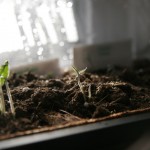

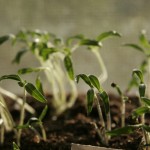
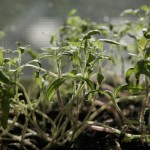
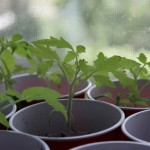
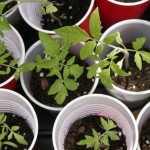
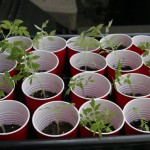
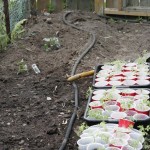
What a terrific gift!
The best way to support your tomato plants is with The Tomato Stake.
http://www.thetomatostake.com
Easier to use than metal cages or upside down planters, stronger than bamboo and won’t rot like wood stakes. The built-in twist-tie supports make tying your tomato plants easy!